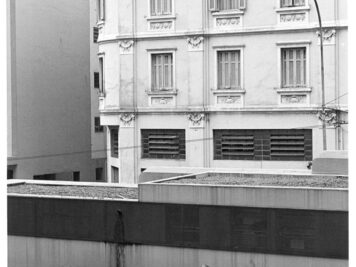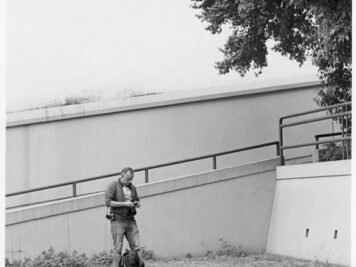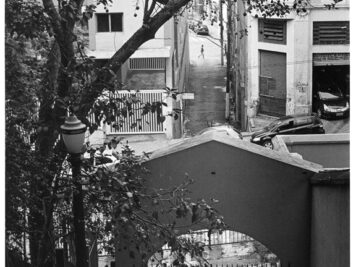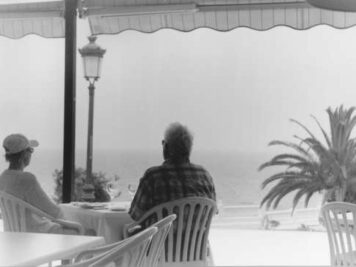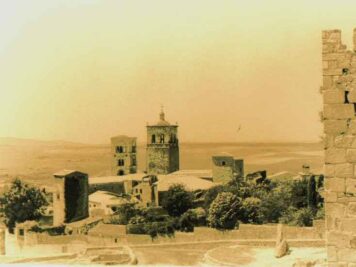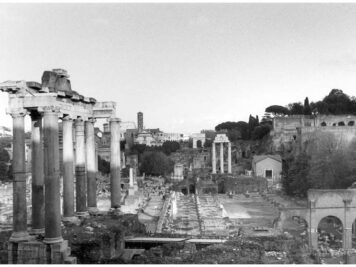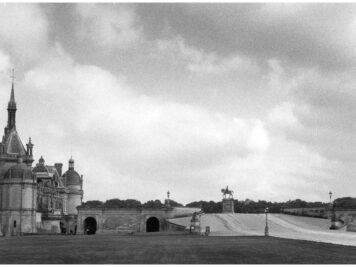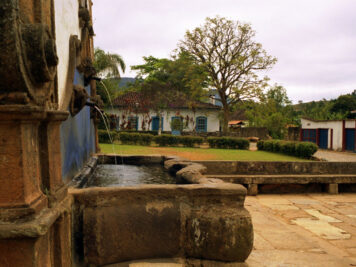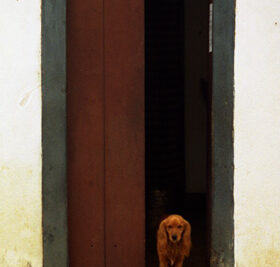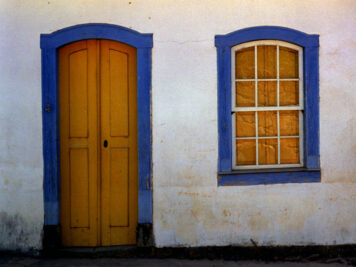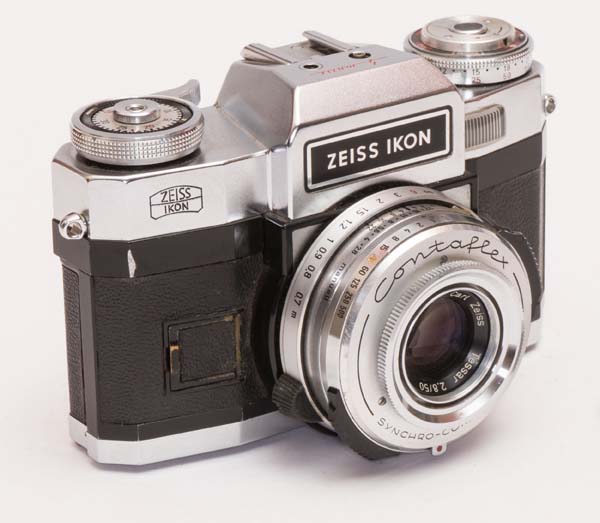
Contaflex Super BC – one of the last models, introduced in 1965, produced until 1969
The first Contaflex was launched in 1953 by Zeiss Ikon and announced the novelty of a monoreflex for 35 mm films with a leaf shutter. That is a central shutter, mounted on the lens axis and it opens/closes by sliding metal blades.
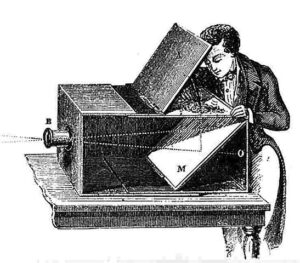 Camera Obscura
Camera Obscura
The monoreflex concept (SLR or Single Lens Reflex), in which a mirror deflects lens’ image to the photographer during composition, is very old and already existed in several medium and large format cameras. The basic idea is a direct application of the camera obscura and therefore prior to photography itself. But due to cameras sizes, all the practicality that we associate with SLRs today was still missing for the first SLRs. The image was inverted right/left and the camera was at waist level. Graflex, from Rochester – USA (at that time still Folmer and Schwing Manufacturing Company in NY), started in 1898 a line of SLR cameras for 4×5″, and even 5×7″, which was very successful. Below is a more recent model, the Graflex Auto RB. I don’t have the exact date of this one in my collection, but this line was advertised until at least the 1950s.
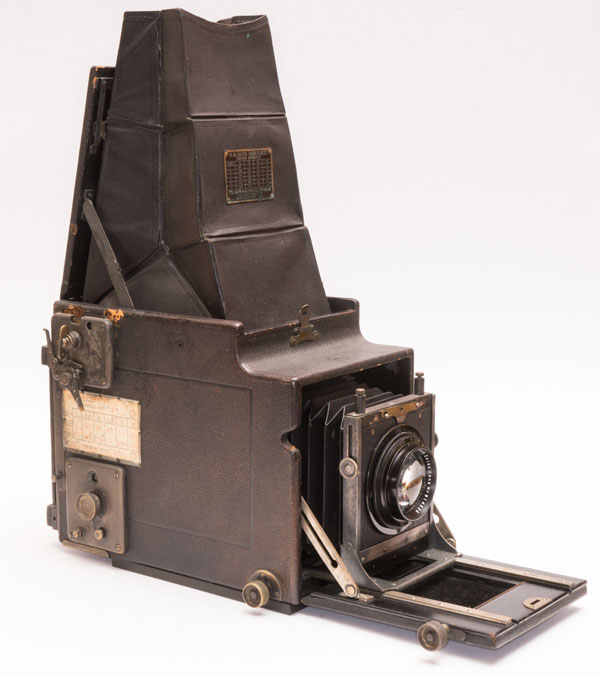
Graflex Auto RB
Zeiss Ikon, on its 1953 Contaflex, could not even say that it was the first 35 mm monoreflex as the Exakta from Ihagee existed since 1936, and also the Praktiflex from Kamera-Werkstätten AG, launched soon after in 1939, both firms based in Dresden. The ironic thing about this advertising appeal: “the first SLR with a leaf shutter”, is that the leaf shutter, then announced as an advantage, would become the main cause of the obsolescence of Contaflex, which stopped being produced in 1972.
Given the influence and weight of Zeiss Ikon in the German and even worldwide photographic industry, perhaps a certain instinct to “follow the leader”, ended up taking other firms along the same path that soon proved to be a dead end. Kodak AG invested in a line of Reflex Retinas starting in 1957 and the centenary Voigtlander, in 1959, when it was already controlled by Zeiss Ikon, came with its Bessamatic and then Ultramatic, both with leaf shutters and discontinued a few years after their launch.
The leaf shutters golden age
In early photography shutters were by no means a concern. Removing and replacing the lens cap was perfectly acceptable for exposures of several seconds or even minutes. After the invention of dry plates, based on silver halide and gelatin, a huge number of shutters, in the most varied concepts, were developed to meet the need for ever shorter exposure times. The first leaf shutters that were developed and patented in Munich by Steinheil, one of the most important lens developers and manufacturer, date from this time, in the 1880s.
In 1905 Friedrich Deckel and Christian Bruns, both ex-Steinheil, launched the Compound shutter. It was a leaf-shutter shutter in which the mechanism for delaying the closing of the blades consists of a piston that expels air from inside a valve. With air slowly exiting through a small opening, this pneumatic device delays the movement of a spring that otherwise would be too fast. It was a huge success and continued to be manufactured until the late 1960s.

Compound shutter. The small cylinder on top of it is a pneumatic piston. which slows the action of the spring that closes the shutter blades.
After a separation, Christian Bruns, in a new project, abandoned the pneumatic concept and replaced it with a clock mechanism to delay the closing of the shutter blades. This was named Compur, which would be a combination of Compound with the German word Uhrwerk which refers to the mechanism of watches. Below is an exploded view of the Synchro Compur shutter, the type that equips Contaflex and the majority of the most sophisticated cameras of its time.
In this illustration, the 5 blades that open and close for the passage of light are marked and below we see part of the clock mechanism characteristic of these shutters.
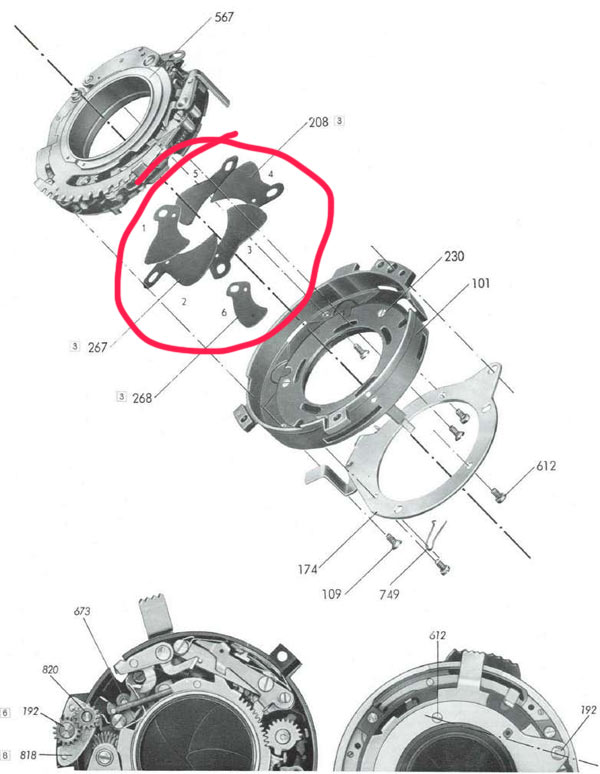
Realizing the strategic importance of such a component, Carl Zeiss bought the patent and started a cooperation with Friedrich Deckel for the new shutter production. This story is very well told, with much more detail, on the page Up and down with Compur, that is an article from Klaus-Eckard Riess, translated to English by Robert Stoddard.
In this short introduction I just wanted to point out the long relationship, dating back to 1910, between the future Zeiss Ikon (which resulted from the merger of four companies in 1926) and the Friedrich Deckel of Compur shutters. It was very important for the future of photography that Zeiss Ikon, camera manufacturer, was already born strategically and historically linked to Friedrich Deckel GmbH, leader in leaf shutters. Zeiss Ikon even had an equity stake in the shutter company and together they had a certain dominance of the camera market due to the technology embedded in these devices. Deckel not only manufactured its shutters, it also manufactured the necessary machinery capable of producing the tiny parts employed in these high-precision mechanisms. Any other camera manufacturer that wanted to employ the prestigious and coveted leaf shutter Compur needed to have the blessing of its competitor Zeiss Ikon.
In order not to make this part too long, I just want to show you an excerpt from a letter that on November 25, 1933, Deckel wrote to the director of Carl Zeiss, Paul Henrichs. That’s when he learned that Zeiss Ikon was developing a camera, Contax, with a focal plane shutter. Such development, whose objective was to compete with Leica from Leitz – Wetzlar, in Deckel’s view violated previous agreements between the two firms:
“Zeiss Ikon equips ever more models with focal-plane shutters, which for me is in the end just as unfavorable as if it would equip these cameras with another make of leaf shutters, because the business is to me effectively lost. In addition, through these measures, more and more propaganda is made for the focal plane shutter, which must also have an unfavorable effect for my shutter production. A really friendly co-operation can take place nevertheless, but only if more consideration for my company is taken in this matter in Dresden.“(source is again Klaus-Eckard Riess’ article).
Meanwhile, in the 1930s, Ihagee, also in Dresden, launched the Exakta monoreflex for 127 film and shortly thereafter the Kine Exakta for 35 mm, both with focal plane shutters. Perhaps because of a visionary talent, perhaps because of difficulties in breaking through the lobby that already lined Zeiss Ikon, Deckel, Gauthier (another important shutter manufacturer) and even Kodak and Bauch & Lomb, across the Atlantic, chose to develop focal plane shutters. Exakta could and was on track to have a bright future and safeguard better German share in the monoreflex boom of the 1960s. But war came, Ihagee stayed on the eastern side of Germany, new management, new mindset and it lost its ability to innovate and compete in the international market.
That’s how the post-war, until the 1960s, was all leaf shutters. With the reconstruction and resumption of production, the market was quickly invaded by a huge amount of cameras of all types, but mostly using leaf shutters. For example, in medium format, folding cameras such as Ikontas and Super Ikontas, Bessas from Voigtlander, Agfas, or folding 35 mm such as Contessa or Contina, Vitessa, viewfinder cameras like Vito and Prominent from Voigtlander, Retinas from Kodak, TLRs like Rolleiflexes… with varying degrees of sophistication, the overwhelming majority of them came with Compur and Prontor shutter models from Deckel or Gauthier, respectively. In Riess’s article, quoted above, we read that: “Between 1957 and 1960 leaf shutter production exploded. The production lines for Gauthier’s Prontors in Calmbach employed 3250 workers and shipped 10,000 shutters daily. Deckel, producing its shutters in Munich, employed approximately 1500 people at that time.”
Pros and Cons
Even without thinking about their complexity and cost, leaf shutter have few advantages over focal plane in small format photography. The most relevant are:
- They are much less subject to vibrations. The movement of its parts is reasonably symmetrical. They are also much quieter than curtain shutters. But both vibration and silent operation are advantages that lose a large part of their importance in monoreflex cameras as they have the mirror rising and hitting the top of the camera, meaning they are already noisy in nature.
- The other advantage, this one really indisputable, is the possibility of synchronizing an electronic flash at all speeds offered by the shutter. Even at 1/500 a leaf shutter goes through an instant when its fully open. In the case of focal plane shutters, the highest speeds are achieved by having the second curtain departing before the first had run the entire frame. What runs and actually exposes the photo is a slit. In no time is the entire frame exposed and a flash will illuminate only a swath of the entire frame.
Synchronism at high speeds is a real advantage. The defenders of Contaflex also recalled the problem with curtain shutters, in which objects moving at high speed are deformed. They are elongated when they run in the same direction as the curtain or compressed when they run in the opposite direction. This is a fact, but it is not such a common fact to discourage its users.
The disadvantages of the leaf shutter were more decisive, especially in the case of 35mm film cameras. A very attractive point in SLRs is the possibility to change lenses without the inconvenience of separate viewfinders, with parallax problems and small images. But a shutter on the lens itself greatly complicated its design. One possible way out would be each len having its own shutter, but that would be a very expensive solution and would put the system out of reach for most of the amateur market.
The means to get around this was, first, to leave a part of the optics fixed to the camera body along with the shutter. In this system, to obtain another focal length, instead of changing the entire lens, only the front element is replaced.
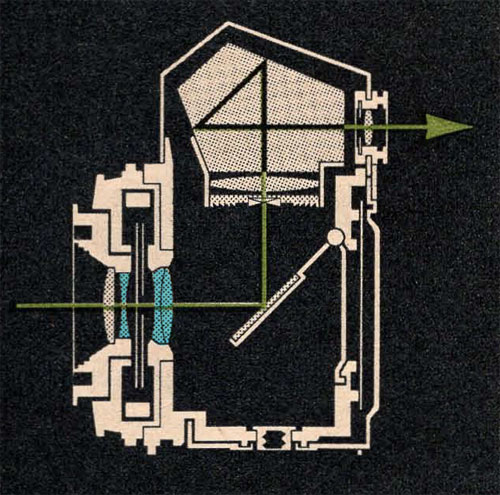
The three rear elements of Tessar, marked in blue in the drawing above, do not leave Contaflex. To get the additional focal distances offered in the camera system: 35, 85 or 115 mm, only the front element is replaced. The shutter is between these two groups, fixed to the camera body.
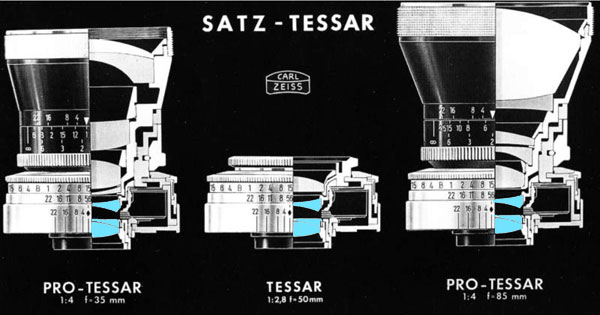
Even without being an expert in photographic optics, anyone can assess, from the illustration above, what was the mess Zeiss Ikon got into. In all three cases we have the original Tessar 50mm rear lenses marked in blue. In order for this common block to work as 85 mm, for example, another 5 elements were added, totaling 8 elements. At the same time, also for an SLR, Exakta, Hugo-Meyer produced the Primotar 1:3.5/85 mm with four elements or the Trioplan 1:2.8/100 mm with only 3 elements. I haven’t seen any performance tests but I doubt that Pro-Tessar justifies the complication of increased cost and weight with a much better quality than other much simpler optics designed for cameras with focal plane shutters.
This was very limiting for the quality and versatility of the optics. While an Exakta 35mm can receive good number of different lenses, short like a Flektogon 25mm f/4 or bright like a Primoplan 75mm f/1.9, or longer like the Telemegor 300mm f/4, thanks to its shutter of focal plane, the Contaflex only goes from 35 to 115 mm at f/4 or f/3.2, with its Pro-Tessars as front complements of fixed optics in the camera body.
In his article, Riess comments that instead of seeing these limitations as good reasons to abandon the concept, Zeiss Ikon engineers saw them as challenges to find more creative and even bold solutions. Good for us today, who can admire the feats they have accomplished, but bad for them, who suddenly found themselves unable to compete and had to close down their operations.
Being a market leader often brings a kind of blindness and the marketing and engineering sectors start to act as if the consumer was going to buy, in the first place, what the manufacturer chooses to manufacture. But the free market is not like that.
Contaflex line-up evolution
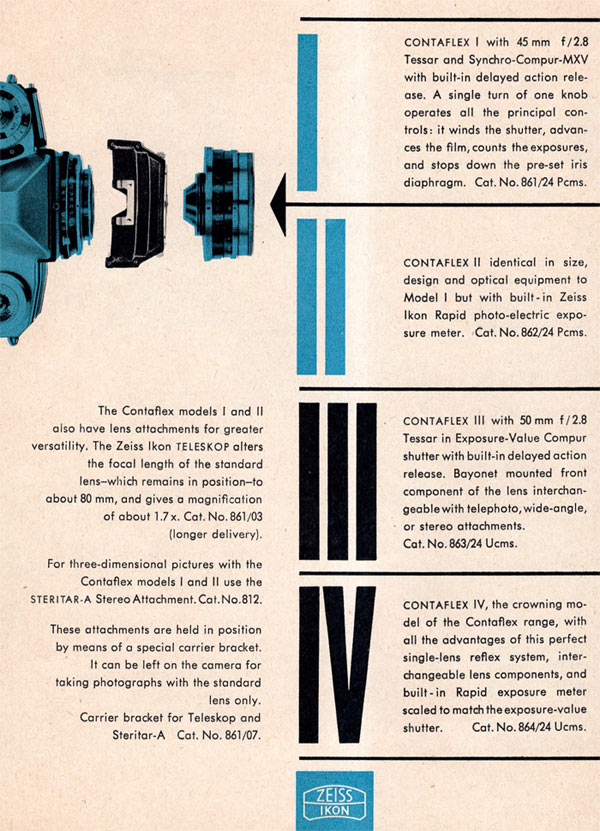
From a Contaflex brochure – source: Pacific Rim Reference Library
Evolution is perhaps not even the most appropriate term as the various models coexisted in Zeiss Ikon’s offering. It wasn’t like one generation replacing another. But I believe that in order of releases we can consider the more sophisticated models as additions to a line that started out relatively simple.
The Contaflex I, as mentioned above, was launched in 1953. It had a Tessar 45mm f/2.8 as a fixed lens. The focus was made by moving only the front element, as in the Zeiss Ikon foldings of the same period. But it was already equipped with a sophisticated Compur MVX. M for bulbs, X for electronic flash and V for timer shooting. Contaflex II only added a selenium lightmeter.
The Contaflex III, launched in 1956, brought the great novelty of interchangeable front elements for different focal lengths, the aforementioned Pro-Tessar lenses. The normal lens was now a Tessar 50mm f/2.8. The shutter now indicated EV, exposure value, a unique number that couples speeds and apertures according to the light condition. But the III didn’t offer a lightmeter.
Contaflex IV was the III with a lightmeter and were launched simultaneously. The logic is: I and II with fixed lenses, the first without and the second with a lightmeter. III and IV with interchangeable lenses, the first without and the second with a lightmeter.
Reading the characteristics highlighted by brochures, manuals and advertisements, we find things that today seem banal but at the time differentiated the line from some other options on the market.
Quite different from a viewfinder camera, with or without a rangefinder, in which the viewfinder image is independent of the image the lens projects, in a monoreflex, at the moment the shutter is released a complex sequence of mechanical operations needs to be traversed:
- Shut the shutter as it needed to stay open for focus and framing.
- Raise the mirror to allow the image generated by the lens to pass through
- But before raising the mirror, lower a lid to protect the film from light as the exposure is actually done by the shutter
- Close diaphragm to selected aperture before shutter opens
- Finally open and close the shutter at the chosen speed.
All this was carried out mechanically on the Contaflex in a time lapse of just 20 milliseconds, since the first model in 1953.
Contaflex Rapid and Super
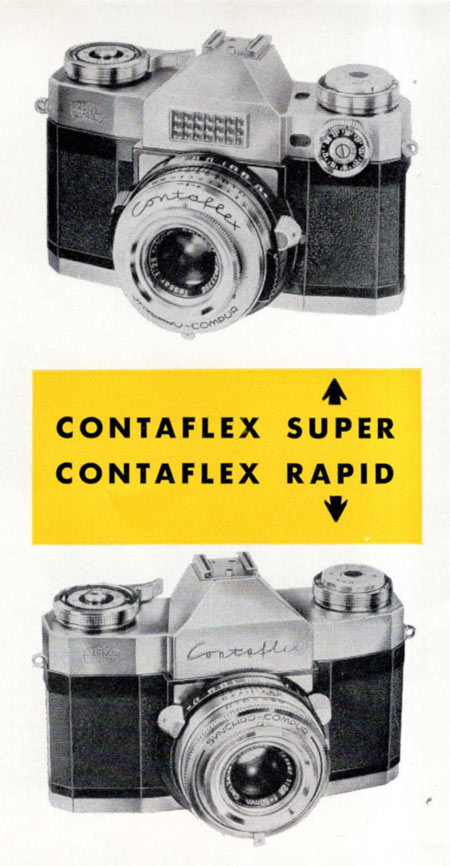
From a Contaflex brochure – source: Pacific Rim Reference Library
Super and Rapid broke the numerical sequence of I, II, III and IV. But it is again a pair of cameras, one without a lightmeter, the Rapid and another with a lightmeter, the Super. Launched in 1958 and 1959 respectively. The interesting thing about this new model with lightmeter was the introduction of its coupling to the camera controls so that the photographer could now adjust the photometry directly in the viewfinder. It even offered a window for reading the photometer on top of the camera. Both Rapid and Super use the same set of Pro-Tessar lenses. They also brought the novelty of a flash shoe fixed on top of the camera.
Contaflex Super, Super B, BC e S
In 1965 a new Super and a Super B were released. With the redesigned body they received a rear capable of changing the film still partially exposed. This must have been especially interesting at a time when color and black and white began to live together intensely. But perhaps the main news is that Super B introduced automatic exposure through a speed-priority selenium lightmeter.
Super BC and S are different names for essentially the same camera. They represent the peak of this Contaflex development. Two fundamental and interconnected changes: the lightmeter uses a mercury battery, in this case a PX-625 or P-13, and photometry is now carried out through the lens.
Until then, it was always some small window in front of the camera, with the selenium lightmeter, which made a general reading of the luminosity in front of the camera. With the super BC a prism placed inside the eyepiece steals some of the light that would go to the photographer and measures the luminosity of what he is actually observing through the lens.
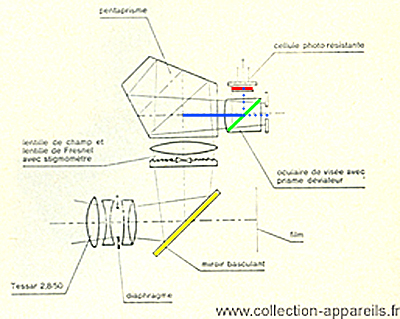
source: Collection Sylvain Halgand
In the picture above I have added some color to help identify the parts of the Contaflex Super BC photometry system: We have the lens, the mirror (yellow), the pentaprism at the top and a ray of light (blue) that splits into two on the surface (green) of a prism. The dotted lines represent this division in which part goes to the eyepiece, where the photographer observes the image, and part goes to the photocell (red).

De uma brochura da Contaflex – fonte Pacific Rim Reference Library
Because of this split of light between the viewfinder and the lightmeter, the use of selenium, which is so convenient as it does not need a battery, had to be replaced by a photoresistor capable of reading significantly lower luminosities. But the novelty was extremely attractive. The photographer from then on not only saw through the lens but also measured the light directly on the lens image. See that it is the first feature highlighted in Contaflex S in the brochure below: Through the lens metering (Cds).
The Contaflex Super BC in the collection
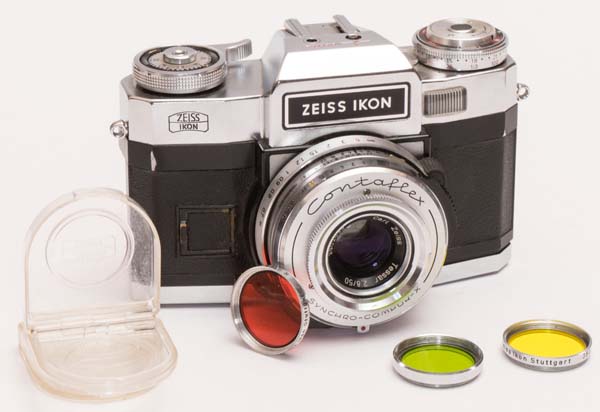
Within the concept it proposes, at Contaflex Super BC everything was resolved with impeccable quality. It feels good in hand, it impresses as a very robust camera and all controls move smooth and firmly. The only thing I find objectionable about the design and construction of this camera is the battery compartment. This is the small door in front of the camera on the left in the photo above. It is very fragile and because it contains plastic it is very easy to find broken ones.
Also about the battery, something important to note is that it uses the old and no longer available MR-9, PX625 or PX13 mercury oxide batteries. There are ways around this problem. I discuss the adaptations on the page about the Olympus 35DC that uses the same battery.
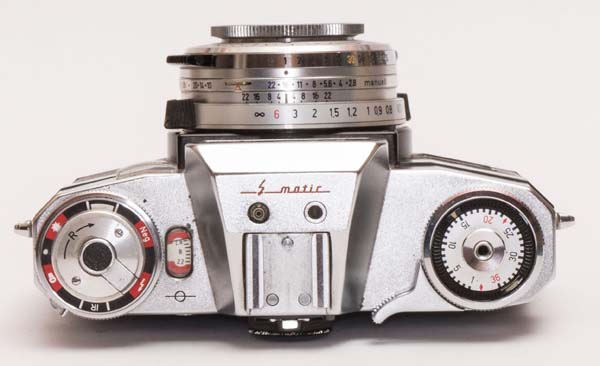
For all the features that Contaflex Super BC has, it can be considered a very compact camera. If we take into account that everything is purely mechanical, that it has a high level of automation and that mechanical things take up space, it is surprising how small it actually is. Controls are well positioned and the display is very bright. The reason for that luminosity, which surprises those who are used to SLRs of the next generations, is that it does not use a ground glass for image formation. Instead, the lens image comes straight through a Fresnel glass, a Fresnel lens, so there is very little loss of light. The eyepiece receives the image without it being diffused by a ground glass one.
This system was abandoned due to the disadvantage that the image cannot be focused on a Fresnel lens. To check any point of the image, it needs to be formed over screen or a ground glass. With the brighter lenses that followed, especially in the 1960s, when f/1.8 or even f/1.4 became common, the darkening caused by the ground glass was compensated by these brighter lenses and the Fresnel system was left behind. .
This means that, observing the Contaflex display, the image is apparently always in focus, even if it is not. To adjust the focus, it is necessary to orient yourself either by the bipartite in the circle in the center of the viewfinder or by the ring around it, as seen in the images below.
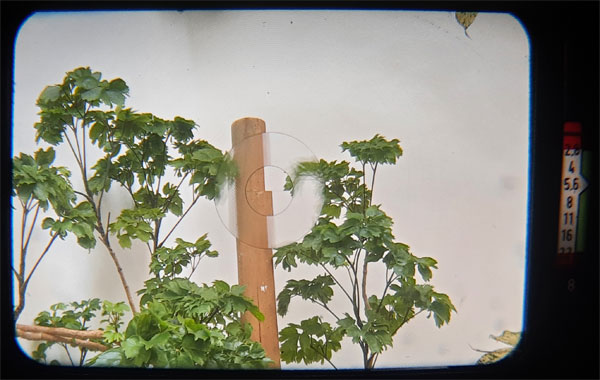
Nesta imagem o anel de foco estava no infinito. Vemos claramente que apenas o centro do visor denuncia esse falha. Abaixo, o foco correto é confirmado tanto pelo bipartido como pelo anel à sua volta onde a imagem torna-se nítida. Note que fora dessa área central a imagem estava nítida nos dois casos.
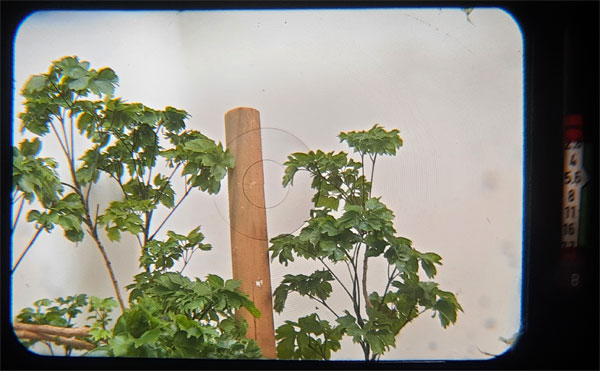
On the right side we have the aperture and speed indication. The speed doesn’t appear in the photo because it was taken with a cell phone and the angle of the shot favored only the scene itself. But in use, both aperture and speed are clearly shown on the display. The only drawback is that the needle indicating the correct opening only appears in automatic mode. This slightly complicates the use of the lightmeter in a fully manual mode.
Another feature that may annoy a bit those used to newer lenses is that the focus is not a ring, as was later widely adopted by all brands. Due to the compression of all controls required by the leaf shutter, a focus ring wide enough to be comfortable would be impossible. Two large, protruding “buttons” were then designed, positioned so that a much thinner ring is actuated by thumb and forefinger.
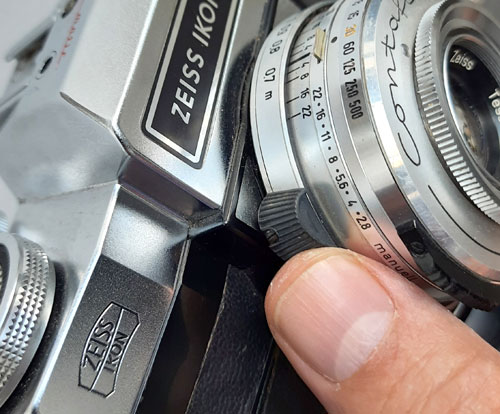
focus adjustment
The frame counter sits on top, at the axis of the film advance lever and it counts down. You must always remember to adjust the number of frames of film right after loading it. Once you reach zero it is no longer possible to advance or shoot the camera, unless you manually reposition the frame counter or rewind the film.
Without cocking the shutter, the lightmeter is not active. This is certainly so that the battery is not required all the time, thus extending its useful life. At the same time, if the camera is left uncocked and, worse still, without the lens cap and/or without the leather case, the battery will surely run out.

In the case of Contaflex Super BC, the lenses were recalculated using computers, a novelty at the time. Its Tessar 50mm f/2.8 is reputed to be especially sharp. I’ve taken a lot of pictures using various Tessar type lenses, starting with the first large format ones like the Tessar IIb with a 70º angle of view and f/6.3. Also with Tessar made for the Linhof 6×9 and many for 35 mm. I didn’t do rigorous tests, I don’t know if it was luck, but when using this Contaflex, Tessar usually surprises me with the sharpness of the details. So I’m more for reverberating the fame it has for being a special strain of this historic design.
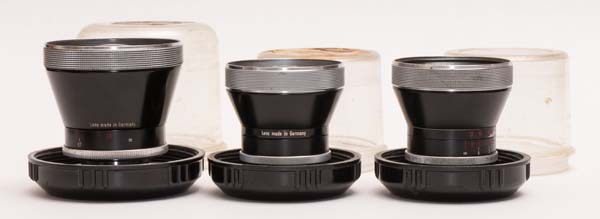
Above we have 115 mm f/4, 85 mm f/3.2 and 35 mm f/3.2. There are 35mm and 85mm versions at f/4. They are heavy and give an idea of the complexity that the Zeiss engineers undertook to have this system with part of the optics fixed to the camera and only the interchangeable front. As stated above, if we compare these Pro-Tessars with lenses with similar focal length of the Voigtlander Bessamatic system, we will see that the latter are much lighter and smaller, we can imagine a significant cost difference that the construction of the Contaflex represented.
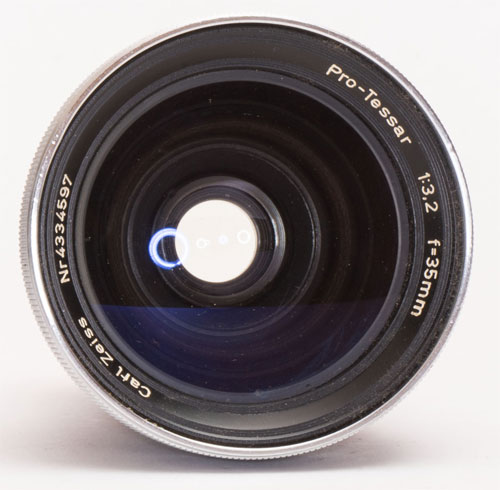
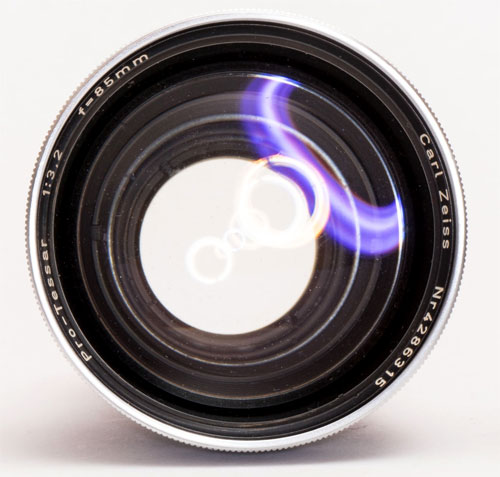
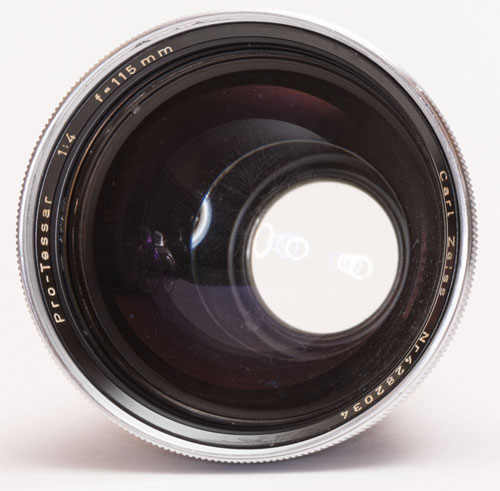
It’s important to note that Pro-Tessars, are different from converters that we add to a normal lens to open or close its angle of view. These converters, called tele or wide, apply to complete lenses that themselves already form images. But the Tessar center group plus the rear doublet do not form a complete lens, it is only completed by the addition of the front element.

The back cover of Contaflex is not the hinge type as it was later adopted by monoreflex and 35mm cameras in general. It is like the ones we find in the Contax line. Perhaps this is important for the interchangeable rear system that came with the latest cameras in the series.
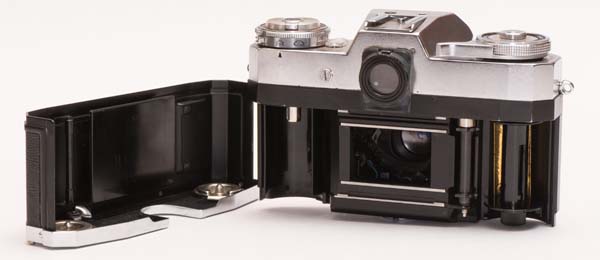
Overall, as a conclusion from my experience with Contaflex, it’s a beautiful, reliable, robust and well-built camera. As fate would have it, some premises of its construction imposed barriers and limitations that the creativity of Zeiss Ikon engineers did very well to overcome. That’s how they created this jewel without a future.

Some pictures taken with a Contaflex
